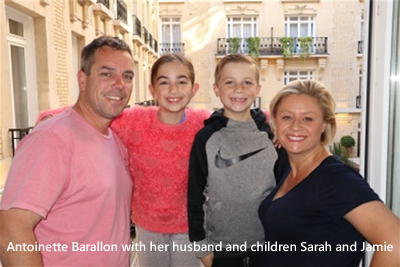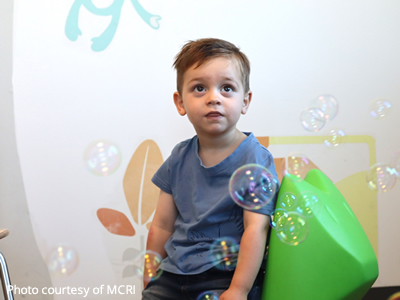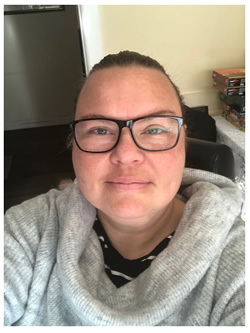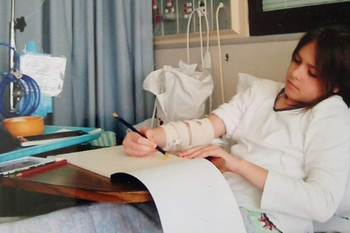 Birthday parties and meetings with friends used to bring danger for Sarah because of her potentially deadly allergy to peanuts. But after receiving treatment to build up her immune system’s tolerance to peanuts as part of a Murdoch Children’s Research Institute (MCRI) research project, Sarah is now free to enjoy socialising without fear.
Birthday parties and meetings with friends used to bring danger for Sarah because of her potentially deadly allergy to peanuts. But after receiving treatment to build up her immune system’s tolerance to peanuts as part of a Murdoch Children’s Research Institute (MCRI) research project, Sarah is now free to enjoy socialising without fear.
Doctors diagnosed Sarah’s allergy when she was still an infant and her mum, Antoinette, says it was a frightening and life-altering discovery. “People think it’s a lifestyle choice. It’s not,” Antoinette says. “People need to realise that consuming food that you are allergic to won’t just make you ill, it could potentially lead to anaphylaxis. It is absolutely terrifying.”
Peanut is the most common cause of life-threatening allergic reactions (anaphylaxis). Currently, the only treatment for peanut allergy is to avoid peanut. This causes lifestyle restrictions and anxiety about accidentally eating peanut, especially when eating out.
Project lead Professor Mimi Tang and MCRI researchers have been trialling two new oral immunotherapy (OIT) treatments – a peanut OIT on its own (increasing daily doses of peanut protein) or peanut OIT combined with a probiotic.
Results show that both peanut allergy treatments, the rapid escalation high dose OIT and the combination OIT plus probiotic achieved remission in around half of patients who were treated, and full desensitisation in an additional quarter of treated patients. Three quarters of patients achieved protection against standard serve amounts of peanut. Both treatments led to significant and substantial improvement in quality of life after 12 months – the first treatments that have been shown to do this.
“Addition of a probiotic did not significantly improve effectiveness compared to oral immunotherapy, however it appeared to enhance tolerability of the treatment, with fewer gastrointestinal symptoms, especially in children between one and five years of age,” says Prof Tang. “High dose peanut oral immunotherapy provides meaningful benefit to treated children”.
Dr Paxton Loke of MCRI said that, remarkably, 99 per cent of children who achieved remission and ceased treatment were eating peanut as frequently as they liked in the 12 months after stopping treatment.
Antoinette says she often tells her children what a privilege it is to be part of trials that are helping other kids with food allergies. “What the MCRI researchers are doing with food allergies right here in Australia is remarkable,” she says.
The Allergy and Immunology Foundation of Australia (AIFA) awarded Professor Mimi Tang the Ann Kupa Food Allergy Research Grant in 2021 to extend this work. This grant will fund a study investigating the underlying mechanisms that support remission of allergy, which will lead to better long-term treatments for peanut allergy. Read more: Immune mechanisms underpinning remission of allergy
The new research was published in The Lancet Child & Adolescent Health https://www.thelancet.com/journals/lanchi/home
AIFA is the only Australasian charity that is specifically funding allergy and immunology research.
Help us continue this work www.allergyimmunology.org.au/donate
Content updated 2022


 Emerson - Food Allergy and the Vitality trial.
Emerson - Food Allergy and the Vitality trial.  Michelle - Severe drug allergy.
Michelle - Severe drug allergy.  Josephine - Systemic Lupus Erythematosus (SLE), also known as Lupus.
Josephine - Systemic Lupus Erythematosus (SLE), also known as Lupus.  Lauren - Food Allergy (walnuts and pecans).
Lauren - Food Allergy (walnuts and pecans).  Emily - Common Variable Immune Deficiency (CVID).
Emily - Common Variable Immune Deficiency (CVID). 

 Michael - Food allergy.
Michael - Food allergy.  The first time Emerson tried cow’s milk he broke out in hives and his eyes and lips swelled. Emerson was just seven months old when he had an allergic reaction after having a few spoonsful of his sister’s strawberry smoothie.
The first time Emerson tried cow’s milk he broke out in hives and his eyes and lips swelled. Emerson was just seven months old when he had an allergic reaction after having a few spoonsful of his sister’s strawberry smoothie.

 Josephine Riek is 22 years of age and has Systemic Lupus Erythematosus (SLE), also known as Lupus. On 10th May 2019, World Lupus Day, she shaved her head to draw attention to this autoimmune disease and raised almost $3,000 for AIFA, the Allergy and Immunology Foundation of Australasia. Josephine is passionate about helping to find a cure for this debilitating illness.
Josephine Riek is 22 years of age and has Systemic Lupus Erythematosus (SLE), also known as Lupus. On 10th May 2019, World Lupus Day, she shaved her head to draw attention to this autoimmune disease and raised almost $3,000 for AIFA, the Allergy and Immunology Foundation of Australasia. Josephine is passionate about helping to find a cure for this debilitating illness. "By the age of nine, my diagnosis was confirmed as Systemic Lupus Erythematosus. The first drug to be prescribed was a steroid, which unfortunately on high doses comes with many side effects, especially for young children."
"By the age of nine, my diagnosis was confirmed as Systemic Lupus Erythematosus. The first drug to be prescribed was a steroid, which unfortunately on high doses comes with many side effects, especially for young children." The money Josephine received from fundraising on GoFundMe went directly to AIFA research projects.
The money Josephine received from fundraising on GoFundMe went directly to AIFA research projects. With severe allergies to peanut, pecan, cashew, walnut, pine nut, pistachio and sesame, Michael, now in his 30's, has been dealing with food allergies and anaphylaxis his whole life. Eating has always been a balance of being careful, but still enjoying and experiencing lots of different foods and he’s managed it very well. But Christmas brings additional challenges for people with severe food allergies.
With severe allergies to peanut, pecan, cashew, walnut, pine nut, pistachio and sesame, Michael, now in his 30's, has been dealing with food allergies and anaphylaxis his whole life. Eating has always been a balance of being careful, but still enjoying and experiencing lots of different foods and he’s managed it very well. But Christmas brings additional challenges for people with severe food allergies.